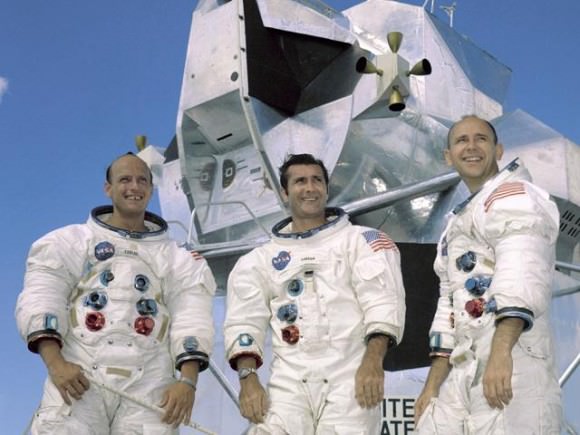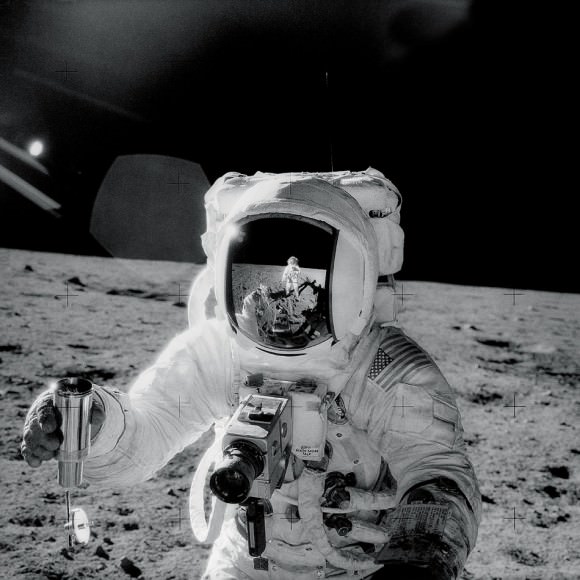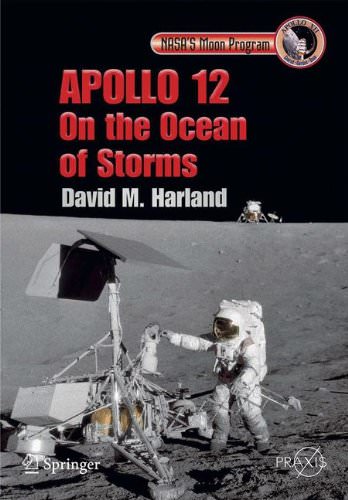[/caption]
As one chapter in manned space flight draws to a close, it is human nature to look back, to draw parallels and to remember similar points in time. A new offering from Springer-Praxis details man’s second landing on the surface of another world, the 1969 mission of Apollo 12. The book is entitled; Apollo 12 On the Ocean of Storms. Strangely, this is the first time that the full story of man’s first trip to the Ocean of Storms has ever been written down. The story in-and-of-itself is compelling, filled with peril, discovery and friendship.
President Nixon was at the launch, but a storm had blown in. The launch went ahead regardless and the Saturn V rocket thundered into the sky – where it was struck twice by lightning. The lightning traveled down the rocket’s plume and struck the pad. On board the Yankee Clipper (the Command Module in which the crew rode), fuel cells, inertial guidance platform and telemetry system went offline.
EECOM John Aaron in Mission Control, with the help of Lunar Module Pilot Alan Bean, saved the day by remembering an obscure procedure, and once in orbit the spacecraft was restored to full operation.
By setting down on the Moon close by an unmanned probe, Apollo 12 showed that precision lunar landings were possible, that microbes could survive for years inside such a robot in that harsh environment – and that friends can make the best crewmates.
This is just a tiny hint of the richly detailed story that is Apollo 12. When it came time to select an author to tell this tale, Springer tapped one of the best in the business – David M. Harland.
Harland is one of the most prolific, accurate authors in his field of expertise – aerospace history. As such, when he started to cover the Apollo era, fans were waiting with great anticipation for his chronicles covering the greatest era in human exploration.

“I wrote this book as part of my series on NASA’s Moon program. I started with Apollo 11, and will work sequentially with books devoted to each of the missions which landed on the Moon, explaining the planning, assembly of the vehicles, launch through to splash, and the scientific insight gained,” said Harland during a recent interview. “People tend to remember the Apollo 8 flight around the Moon at Christmas 1968, the Apollo 11 landing, and the aborted Apollo 13 mission. Yet the missions which followed Apollo 11 and landed on the Moon were far more than ‘flags and footprints’, they were scientific exploration – indeed as one of the astronauts said, ‘exploration at its greatest’. I’m delighted that Springer-Praxis has given me the freedom to write this series.”
Springer Praxis has developed a virtual library’s worth of books regarding space flight. Apollo 12 On the Ocean of Storms is a very worthy addition to this collection and can be found online at Amazon.com. The book includes 530 pages with dozens of historic, color images.



I always liked the above image of Alan Bean. It looks like he is enjoying a morning coffee from his fancy NASA thermos.
I recall an unexpected incident in the first few hours of the first Apollo 12 moonwalk (EVA 1). One of the astronauts accidentally pointed the (live) color video camera directly into the sun while panning it around to take in the view. This pretty much fried the video tube, resulting in no live video from the moon for the remainder of their stay on the Moon.
I had hoped to photograph images of the the moonwalk off TV as I had done with Apollo 11 previously, and the loss of a live signal was, uh, a major bummer…..to say the least. 🙁
I see Wikipedia has this account:
“To improve the quality of television pictures from the Moon, a color camera was carried on Apollo 12 (unlike the monochrome camera that was used on Apollo 11). Unfortunately, when Bean carried the camera to the place near the lunar module where it was to be set up, he inadvertently pointed it directly into the Sun, destroying the SEC tube. Television coverage of this mission was thus terminated almost immediately.[9]”
___________________________________________
“…..that microbes could survive for years inside such a robot in that harsh environment…..”
There seems to be some controversy over this claim (possible ‘breach of sterile procedure’ while the camera was being examined AFTER return to Earth): http://en.wikipedia.org/wiki/Reports_of_Streptococcus_mitis_on_the_moon
I remember watching the live broadcast when Bean accidently pointed the TV camera into the sun, burning it out. As Bean twisted the camera around, you could see reflections of the sun in the lens quickly approaching the field of view. I actually yelled out loud at my television set: “”Watch out!!!” two seconds before the picture went haywire. You could see it about to happen.